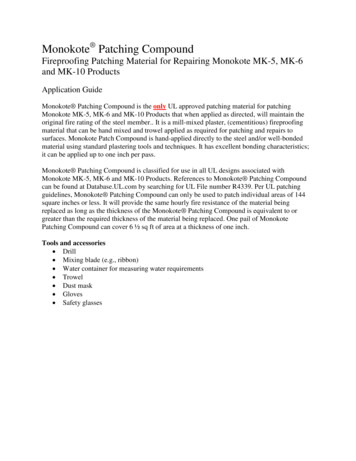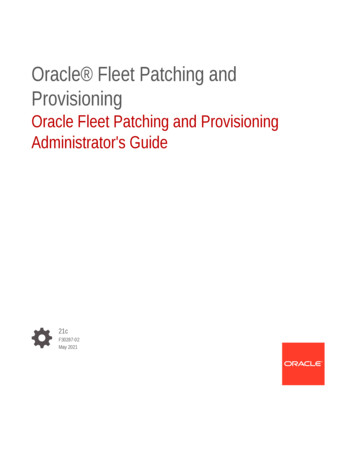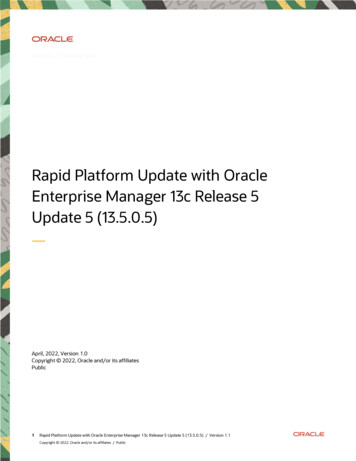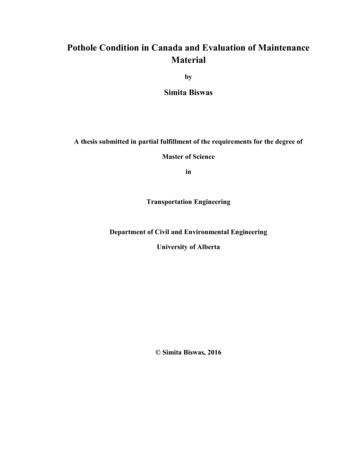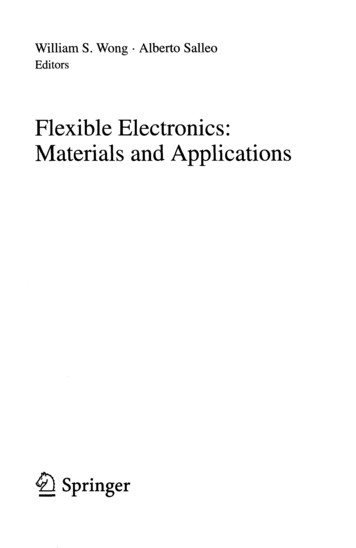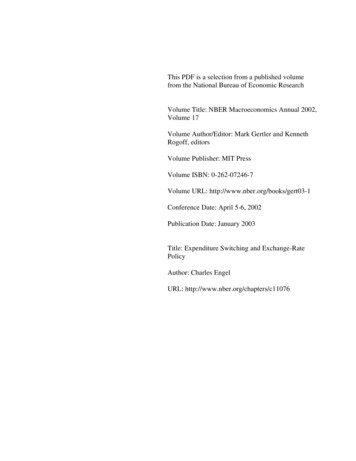
Transcription
TRANSPORT FOR NSW (TfNSW)QA SPECIFICATION TfNSW M250HEAVY PATCHING (FLEXIBLE PAVEMENT)NOTICEThis document is a Transport for NSW QA Specification. It has been developed for use withroadworks and bridgeworks contracts let by Transport for NSW or by local councils in NSW. It is notsuitable for any other purpose and must not be used for any other purpose or in any other context.Copyright in this document belongs to Transport for NSW.REVISION rst edition.GM, RNIC06/07/043.2.1, 4.1.2and 4.5.3Various amendments.GM, RNIC28/01/05B.2Units of measure changed for item 263.Ed 1/Rev 0Ed 1/Rev 1Description of RevisionDefinitions added or altered.Ed 1/Rev 21.1New clause re intended use.GM, RNIC10/08/06Ed 1/Rev 3TablesCorrected table numbering: a) Rev 2 had twoTables M250.3 and b) the table nownumbered M250.4 was unnumbered.Corrected cross-references to Tables.GM, IC31.08.075.5.2Made the requirement that the patch’s levelmatches adjacent pavement specific toundeformed adjacent pavement5.5.3Made “no ponding” applicable to bothdeformed and undeformed adjacentpavement.Ed 1/Rev 4MostFormat correctedGM, IC24.10.07Ed 1/Rev 5AllTo match new Maintenance Activities: Changed Pay Items Changed references to other similarlychanged specificationsRemoved Deduction mechanismsGM, IC04.08.08Changed internal referencing format5.10Edition 2 / Revision 2June 2020Added clause re Accomplishment reporting.TRANSPORT FOR NSW
Ed/RevNumberClauseNumberEd 2/Rev 0Ed 2/Rev 1Ed 2/Rev 2bDescription of RevisionAuthorisedByDateGeneral technical review, and revision ofsome technical requirements. Requirementsadded for mix design, stockpiling, andconstruction for modified/bound granularmaterials which were previously included inRMS 3061. RMS 3061 has been replaced byRMS 3051. Annexure E added. Formatrevised.GM, IAM19.02.134.10.3.4Clause reference to spec SI/TCS/8(withdrawn) replaced with spec TS101.MCQ14.10.19Annex MReferenced Documents updated.GlobalReferences to “Roads and MaritimeServices” or “RMS” changed to “Transportfor NSW” or “TfNSW” respectively.DCS22.06.20
GUIDE NOTES(Not Part of Contract Document)THESE NOTES ARE NOT PART OF THE SPECIFICATION, CONTRACT OR AGREEMENT.The following notes are intended to provide guidance to TfNSW personnel on the application of theSpecification. They do not form part of the Specification, Contract or Agreement.USING TFNSW M250TfNSW M250 has been specifically developed for TfNSW maintenance works. It must not be usedwithout a review of its suitability for the application and in the contractual environment.M250 is a QA specification. The use of QA specifications requires the implementation of a qualitysystem by the service provider which meets the quality system requirements specified in TfNSW Q.DEFINING HEAVY PATCHING LIMITSThe purpose of this section is to assist in determining when a pavement repair should be considered asheavy patching and therefore when this specification should be used.Pavement repairs will vary from pothole patching (refer M3) to reconstruction works (refer M290). Invery general terms, a repair changes from a pothole to a heavy patch when the failed material must beexcavated to enhance road user safety and with the intention to repair the defect to a lifecommensurate with the remaining life of the pavement.It becomes rehabilitation when there is a significant investment in funds and therefore it is consideredthat detailed investigation and pavement design is warranted together with a full regime of product andprocess testing. Rehabilitation will generally provide for a service life in excess of 10 years.Rehabilitation works will typically be larger in size than heavy patching and would not requirechanges to geometry or formation width.It becomes a reconstruction when the design provides for a service life typically in excess of 20 years.Reconstruction will address design standards such that the asset can be said to be “recapitalised” whenthe works are complete.Both heavy patching and rehabilitation work can be considered generally to be reactive maintenance.The decision as to whether a repair is a heavy patch or something more should generally be based onwhether the cost of detailed investigation, design and works testing is warranted by comparison withthe possible costs of premature failure of the repair. It is in effect a risk analysis, and will always be amatter of professional judgement.While it is not possible to provide a simple checklist for making this judgement, the following tablesets out a number of general factors that would normally be taken into consideration.It is emphasised that each criterion listed in the column headed “Heavy Patch” in Table GN 1 shouldbe preceded by the word “generally”. The final decision will be based on an overall view of all thesefactors together with any others that might apply in particular situations or locations.Table GN 1 – Defining heavy patchingAttribute / CharacteristicHeavy PatchMore than a Heavy Patch(Rehabilitation or Reconstruction)Intended lifeMatch surrounding pavement, generally 10 yearsGenerally:Rehabilitation 10 years;Reconstruction 20 yearsInvestigation/geotech etc.Generally no – or minimalYesPavement designGeneric or rule of thumbYesEd 2 / Rev 2Notes page 1
Attribute / CharacteristicHeavy PatchMore than a Heavy Patch(Rehabilitation or Reconstruction)Testing of materialsApprove source based on past testingand knowledgeYesTesting of processSimplistic – trials and process monitoringYesResponse time – safety issueShort term or part of pavement strategyPlannedTrack performance 1 yrGenerally noYesSize of repairIndividual or close group of patches:** for AC 500 m2 for granular 1,000 m2No limit, small or largeSurface LevelGenerally UnchangedMay changeAlignmentUnchangedMay changePeripherals (eg, formation widthand drainage)UnchangedMay changeConfined to traffic lanesGenerallyNot necessarilyExcavation methodHand, minor plant, major plantMajor plantWidthGenerally 1 laneGenerally full width or multiple lanes**Note: these limits in particular are intended as a very general indicator only. They are not in any way binding on specifiers, whoshould take the whole range of variables into consideration when deciding whether a repair is a heavy patch.CATEGORIES OF HEAVY PATCHESHeavy patches may vary in size from less than one square metre to many hundreds of square metres.Construction methods will also vary from hand-tools (shovels and rammers) through small plant(typically backhoe and compactor, or light roller) to major plant (grader, paver, heavy rollers etc.).The size and distribution of the defects will influence the appropriateness and choice of constructionequipment. In turn, the achievable quality of the finished patch will be influenced by the constructionmethod.Heavy patches are categorised according to the construction methods that are practical in each case.The size and distribution of patches will generally dictate the construction methods to be used, and inturn those methods will affect the quality of work that can be achieved.The specification provides for three categories of heavy patches and construction methods:(a)Hand heavy patches (typically shovels and rammers).(b)Minor heavy patches (typically back-hoe and vibrating plate or light roller).(c)Major heavy patches (typically grader, paver, milling machine, heavy roller).PLACEMENT TRIALSWhen it is proposed to issue Work Orders for a heavy patch, it will be necessary for Placement Trialsto be carried out in accordance with the Specification.For example if it is proposed to order work within all three categories, then three sets of PlacementTrials should be carried out.The aim of Placement Trials is to reduce the amount of testing required throughout the works to areasonably practicable level. The trials will be monitored and tested and the Contractor will then beaccountable to comply with the accepted construction methodology, which will be documented in theContractor’s Quality System.Notes page 2Ed 2 / Rev 2
The Specification makes a clear distinction between testing requirements for Placement Trials andongoing work. It also allows the Principal to carry out additional testing (at the Principal’s cost)whenever the Principal has reason to believe that the quality of work has altered due to any change inconstruction methods, materials, or service conditions etc.In some instances, it may be considered desirable to increase the size of a Placement Trial to avoid thenecessity for the Contractor to disestablish or incur idle plant costs while awaiting test results and therelease of the Hold Point for continuation of heavy patching works. In this event, the Contractor willnot be responsible for re-working costs for the work in excess of the minimum Placement Trialrequirements. While such a strategy involves the TfNSW in carrying additional risk, it may beconsidered warranted following evaluation of the overall costs involved.PAVEMENT DESIGNS AND LAYER THICKNESSIt is expected that normal practice will be to use a number of generic pavement designs for heavypatches, rather than carrying out detailed investigations and designs. These generic sections will bebased on average service conditions in a network area, with perhaps minor variations to allow for localconditions.Where the existing pavement profile is unknown, and/or there is a history of patch failures in an area,some investigation and individual design may be required. The proper methodology for managing thepavement design process is set out in Infrastructure Life Cycle Management System, TechnicalProcedure ILC-AM-TP3-102 Management of pavement design.The pavement design and patch limits should be based on a consideration of the possibility of furtherfailures developing within or around the patch perimeter as a result of incompatible materials,permeability, and drainage issues.Designers of heavy patches should always take into consideration the nature of the site and trafficconditions when customising this Specification. For instance, specifying a treatment that must betrafficked at the end of a shift (eg thick asphalt layers which may not cool in time to take traffic, orinsitu stabilised granular material which may not have been able to be dried back) may require theContractor to consider the cost and risk implications, and negotiate with the Principal accordingly.A review and consideration of drainage aspects is always important. It is essential to keep water outof the pavement structure and to keep the subgrade as dry as possible to maximise its bearing capacity.Consideration should be given to minimising moisture movement vertically into the pavement as wellas lateral movement from the adjoining pavement. Transverse and longitudinal permeability reversalscan result in “damming” of water either in the surrounding pavement or in the new patch which canlead to accelerated pavement failures. Table drain maintenance minimises water movement into thepavement and along with subsoil drains lowers the water table.Note that SELECTED MATERIAL has been included in M250 essentially to facilitate the provision of aworking platform, which may be necessary in some instances to ensure that new material may beplaced and/or the compaction standard is achieved.A pavement course will typically comprise more than one layer.Ed 2 / Rev 2Notes page 3
The as-constructed thickness of each pavement layer in the heavy patch should generally conform tothe requirements shown in Table GN 2:Table GN 2 – General limits on pavement layer thicknessMaterialAs-constructed thickness of compacted layerMinimumMaximumUnbound and Modified Granular Pavement Material150 mm200 mmBound Granular Pavement Material175 mm250 mmSelected Material150 mm200 mmSand Cement Mix for Pavement Subbase200 mm300 mm3.0 times the nominal mix size5.0 times the nominal mix sizeAsphaltWhere a design specifies layer thicknesses and the Contractor proposes to vary these, the Principalmay approve a proposal to place alternative layer thicknesses (including at corrections and tie-ins)provided that the proposal includes details of:(i)Work methods to ensure that for thinner than specified layers, a dense homogeneous layer freefrom cracks will be provided.(ii)Work methods to ensure that for thicker than specified layers, relative compaction or insitu airvoids (whichever is relevant) conform to specified requirements.(iii)Proposed maximum and/or minimum layer thickness.(iv)Evidence that affected areas are the absolute minimum necessary to conform to the work siteconstraints and that, as far as possible, the layer thickness conforms to the specified tolerances.Any changes to the specified layer thicknesses may require further Placement Trials.PAVEMENT MATERIALSThe pavement materials to be used in patching works must be shown in Annexure A.1.PAFV FOR SURFACE AGGREGATEWhere considered necessary, the required Polishing Aggregate Friction Value (PAFV) for coarseaggregate in the surface course should be included in Annexure A.PAFV should be based on individual site assessment. The generally accepted minimum value is 44for sprayed seals and 48 for asphalt, but in special locations desirable values could range up to about52. It should be kept in mind that in most situations, the requirement of a high PAFV could result invery substantial increases in cost as special aggregates may have to be imported.LOCATING PATCHESThe scoping of heavy patching works will include defining the location and size of patches as well asdesign details such as layer depths. It is important to give serious consideration to size and location,since this will affect the construction methods (and patch category) and in turn the life andperformance of the finished product.As far as possible, multiple small patches should be avoided. It will usually be more cost-effective tomaximise individual patch areas since this will minimise patch edges, which are areas of potentialweakness due to lower compaction, increased permeability etc. Consideration should be given to notonly patching a failed area, but also any adjacent areas showing possible signs of distress which mayotherwise result in an early re-visit.Patch location should always ensure that there are no longitudinal joints in wheel paths.Notes page 4Ed 2 / Rev 2
For these reasons it is generally desirable to accurately specify location and patch size by marking outon the pavement and ensuring that the patch boundaries extend into sound pavement. This detailshould be provided to the Contractor in the Work Order.Where the Contractor proposes heavy patching work and specific locations, it is essential to ensurethat the Contractor understands these principles and is committed to applying them. Patch locationsmust always be verified and approved by the Principal and details incorporated in the Work Order.EXCAVATION DEPTHWhen milling to a surface specified on the Drawings or the Work Order, the top of the milled surfacemust not vary from the position detailed on the Drawings or in the Work Order by more than thetolerance shown in Table 9 of this Specification.USE OF GEOTEXTILESGeotextiles may be used as a strengthening medium over a weak subgrade by providing some tensilecapacity, and/or to separate the patch from a wet subgrade to minimise the pumping of fines. Theymay also be used in the construction of sub-surface drains as a filter barrier.Table GN 3 indicates the type of geotextile that should be specified for these applications. Note thatfurther guidance is available in TfNSW R63.Table GN 3 – Specification of geotextileApplicationsStrength*Filtration Class*Strengthening and separation layer on weak subgrade: noncritical flow conditionsC1Class 4Trench drain, edge drain and drainage blanketB1Class 1* Refer to TfNSW R63Ed 2 / Rev 2Notes page 5
QA S PECIFICATIONM250HEAVY PATCHING(FLEXIBLE PAVEMENT)Copyright – Transport for NSWIC-QA-M250VERSION FOR:DATE:Edition 2 / Revision 2June 2020TRANSPORT FOR NSW
M250Heavy Patching (Flexible Pavement)CONTENTSCLAUSEPAGEFOREWORD . IIITfNSW Copyright and Use of this Document . iiiRevisions to Previous Version . iiiProject Specific Changes . iii1GENERAL . 12PLANNING . 22.1Project Quality Plan . 22.2Location of Work . 22.3Mix Design (Modified and Bound Granular Materials) . 32.4Placement Trials . 33RESOURCES . 53.1Base Material . 53.2Materials for Replacing Unsuitable Material Below the Base . 73.3Compaction Equipment . 83.4Insitu Stabilisation Equipment . 84EXECUTION . 84.1Temporary Ramps. 94.2Excavation . 94.3Unsuitable Material. 94.4General Requirements. 104.5Material Under Base . 144.6Unbound Materials . 154.7Bound or Modified Materials . 164.8Asphalt Layers . 194.9Related Works. 214.10Protection and Reinstatement of Services, Road Fixtures, and Delineation . 224.11Opening to Traffic . 225CONFORMITY . 235.1Placement Trials . 235.2Continuing Compliance with Approved Construction Processes . 255.3Pavement Density . 265.4Surface Finish and Segregation . 275.5Surface Shape . 275.6General Testing Requirements. 275.7Pavement Course Position . 285.8Friction Value of Surface Course Aggregate . 295.9Warranty Period . 305.10Accomplishment Reporting . 30ANNEXURE M250/A – DETAILS OF WORK . 31A.1Material Requirements . 31A.2Pavement Designs . 32A.3Placement Trial Requirements . 32A.4Location and Details of Work . 33A.5Warranty Period . 33A.6Material Details. 34A.7Information for Identification Certificate . 35ANNEXURE M250/B – MEASUREMENT AND PAYMENT . 36B.1General . 36iiEd 2 / Rev 2
Heavy Patching (Flexible Pavement)B.2M250Schedule of Pay Items . 37ANNEXURE M250/C – SCHEDULE OF HOLD AND WITNESS POINTS AND IDENTIFIED RECORDS . 41C.1Schedule of Hold Points and Witness Points. 41C.2Schedule of Identified Records. 41ANNEXURE M250/D – PLANNING DOCUMENTS . 41D.1Schedule of Key Quality Planning Action Points. 41D.2Supply Method for Pavement Material . 43D.3Production Using Stationary Plant . 43D.4Delivery of Pavement Material. 44ANNEXURE M250/E – RESURFACING AND HEAVY PATCHING DESIGNS . 45ANNEXURE M250/F – DESIGN DETAILS. 46F.1Information to be Submitted for Nominated Materials . 46F.2Information to be Submitted for Each Mix Design . 46ANNEXURE M250/G TO L – (NOT USED) . 47ANNEXURE M250/M – REFERENCED DOCUMENTS AND DEFINITIONS . 47M.1Referenced Documents . 47M.2Abbreviations and Defined Terms . 48LAST PAGE . 49FOREWORDTFNSW COPYRIGHT AND USE OF THIS DOCUMENTCopyright in this document belongs to the Transport for NSW.When this document forms part of a contractThis document should be read with all the documents forming the Contract.When this document does not form part of a contractThis copy is not a controlled document. Observe the Notice that appears on the first page of the copycontrolled by TfNSW. A full copy of the latest version of the document is available on the TfNSWInternet website: onsREVISIONS TO PREVIOUS VERSIONThis document has been revised from TfNSW Specification M250 Edition 2 Revision 1.All revisions to the previous version (other than minor editorial and project specific changes) areindicated by a vertical line in the margin as shown here, except when it is a new edition and the texthas been extensively rewritten.PROJECT SPECIFIC CHANGESAny project specific changes have been indicated in the following manner:(a)Text which is additional to the base document and which is included in the Specification isshown in bold italics e.g. Additional Text.(b)Text which has been deleted from the base document and which is not included in theSpecification is shown struck out e.g. Deleted Text.Ed 2 / Rev 2iii
(TfNSW COPYRIGHT AND USE OF THIS DOCUMENT – Refer to the Foreword after the Table of Contents)TfNSW QA SPECIFICATION TfNSW M250HEAVY PATCHING (FLEXIBLE PAVEMENT)1GENERAL1.1This Specification has been developed specifically for TfNSWmaintenance works. It must not be used in any type of contractwithout consideration of its suitability in the prevailingcircumstances.1.2The work to be executed under this Specification is heavy patchingconsisting of:.1Excavation and preparation of the heavy patch.2Supply and placing of heavy patching materials.3Reinstatement of traffic facilities.4Mix design for modified/bound granular patches.Intended useScope1.3Heavy patches will be ordered in three categories (hand, minor, andmajor) as specified in Annexure A.4.Categories of heavypatches1.4Details of work to be carried out under the Contract are specified inAnnexure A.Details of work1.5Payment for the activities associated with completing the workdetailed under this Specification must be made using the PayItem(s) referred to in Annexure B.1.6The standards, specifications and test methods referred to by thisSpecification are referenced using an abbreviated form(eg TfNSW 3051). The titles are given in Annexure M.1.7Unless otherwise specified, the issue of an Australian Standard orTfNSW Test Method to be used is the issue current one weekbefore closing date for tenders. The TfNSW specification to beused is the issue contained in the contract documentation.1.8Some words or abbreviations have a special meaning in thisSpecification and they are explained in Annexure M. These wordsare highlighted in capitals eg DEFINED TEXT.1.9YOU must provide all responsibilities, such as actions, works,supply of materials, unless specifically stated otherwise.Accordingly, this Specification does not generally use wording suchas " YOU shall " or "YOU must " because this is the underlyingrequirement. However, it is used where actions in a clause involveboth YOU and the PRINCIPAL and the roles need to be unambiguous.Ed 2 / Rev 2Measurement andpaymentReferenceddocumentsApplicable issueDefinitionsInterpretation1
(TfNSW COPYRIGHT AND USE OF THIS DOCUMENT – Refer to the Foreword after the Table of Contents)M2501.102Heavy Patching (Flexible Pavement)Provide the identified records specified in the TfNSW QualitySystem Specification included in the Contract Documents (TfNSWQ) and summarised in Annexure C.2.RecordsPLANNING2.1 PROJECT QUALITY PLAN2.1.12.1.2The requirements of the PROJECT QUALITY PLAN are defined inTfNSW Q. In addition, the PROJECT QUALITY PLAN must:General.1Address the HOLD and WITNESS POINTS required by thisSpecification and summarised in Annexure C.1. ThePRINCIPAL will consider the submitted documents prior to therelease of any HOLD POINT.2Address each of the construction process requirements listed inthis Specification and summarised in Annexure D.1. Theconstruction process must include a detailed processdescription, and inspection and test plans for the work. Theprocess descriptions must be appropriate for the timeallowable before reopening the work to traffic.Constructionprocess.3Include a requirement for the routine submission of conformitydata, which will certify compliance of all work and materialsto the requirements of this Specification, and includesupporting documentation.Conformity data.4Be submitted to the PRINCIPAL at least 5 BUSINESS DAYS priorto commencement of work.SubmissionProcess Held: Commencement of work.Hold and WitnessPointsHOLD POINTSubmission: PROJECT QUALITY PLAN conforming to requirementsof Clause 2.1.Release of Hold Point: The PRINCIPAL will consider the submitteddocuments before authorising the release of the HOLD POINT.2.2LOCATION OF WORKAreas of pavement to be heavy patched are specified inAnnexure A.2Ed 2 / Rev
(TfNSW COPYRIGHT AND USE OF THIS DOCUMENT – Refer to the Foreword after the Table of Contents)Heavy Patching (Flexible Pavement)2.3M250MIX DESIGN (MODIFIED AND BOUND GRANULAR MATERIALS)2.3.1The mix design must be approved prior to the use of any mix.The mix design may be:1. Nominated by the PRINCIPAL, orMix Design(modified andbound granularmaterials)2. Proposed by YOU.2.3.2The PRINCIPAL’S Nominated Mix Design is specified inAnnexure A.6.2.3.3Submit a proposed mix design whenever:.1A Nominated Mix Design is not specified by thePRINCIPAL, or.2YOU propose to change any aspect of a Nominated MixDe
Where the existing pavement profile is unknown, and/or there is a history of patch failures in an area, some investigation and individual design may be required. The proper methodology for managing the pavement design process is set out in Infrastructure Life Cycle Management System, Technical Procedure ILC-AM-TP3-102 Management of pavement design.
